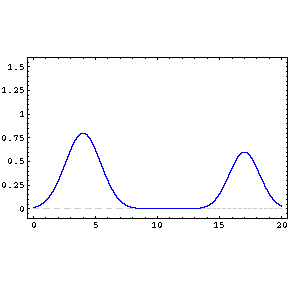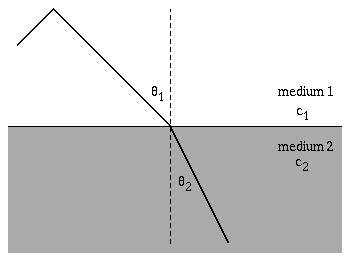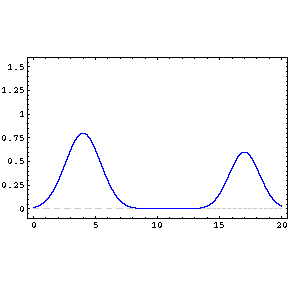Basic Quiz On Waves, Light, Sound, Refraction

- 1.
In this animation, what type of wave is shown?
- A.
Transverse
- B.
Refracted
- C.
Longitudinal
- D.
Light
Correct Answer
C. LongitudinalExplanation
The correct answer is longitudinal because the animation shows a wave that moves in the same direction as the particles of the medium oscillate. In a longitudinal wave, the particles move parallel to the direction of the wave propagation. This can be seen in the animation where the particles move back and forth horizontally as the wave passes through them.Rate this question:
-
- 2.
The material that a wave travels through is called the
- A.
Refraction
- B.
Medium
- C.
Reflection
- D.
Speed
Correct Answer
B. MediumExplanation
The material that a wave travels through is called the medium. The medium can be any substance, such as air, water, or solids, that allows the wave to propagate. The properties of the medium, such as density and elasticity, affect how the wave travels and interacts with objects in its path. Refraction refers to the bending of a wave as it passes from one medium to another, while reflection is the bouncing back of a wave when it encounters a boundary. Speed, on the other hand, refers to the rate at which a wave travels through a medium.Rate this question:
-
- 3.
The type of wave shown is a __________ wave.
Correct Answer
transverseExplanation
The type of wave shown is a transverse wave. This can be determined by observing the wave's motion, which is perpendicular to the direction of the wave's propagation. In a transverse wave, the particles of the medium oscillate up and down or side to side, creating crests and troughs. This is in contrast to a longitudinal wave, where the particles oscillate parallel to the direction of the wave's propagation.Rate this question:
- 4.
In this animation what kind of interference is shown?
- A.
Destructive
- B.
Constructive
- C.
Refraction
- D.
Reflection
Correct Answer
B. ConstructiveExplanation
The animation is showing constructive interference. Constructive interference occurs when two waves combine to create a wave with a larger amplitude. In the animation, it can be observed that the two waves are overlapping and their amplitudes are adding up, resulting in a wave with a higher amplitude. This is characteristic of constructive interference.Rate this question:
-
- 5.
____________ is when a wave, like light, bounces off an object.
Correct Answer
reflection, reflectingExplanation
Reflection is the phenomenon where a wave, such as light, bounces off an object. When a wave encounters a surface, it can be reflected back, changing its direction but maintaining its original properties. This is why we are able to see objects, as light waves reflect off them and reach our eyes. Reflection is an essential concept in optics and plays a crucial role in various everyday phenomena, such as seeing our own reflection in a mirror.Rate this question:
- 6.
What property of waves is shown in the animation?
Correct Answer
refraction, refractingExplanation
The animation demonstrates the property of refraction, specifically refracting waves. Refraction occurs when waves pass through a medium with a different density, causing them to change direction. In the animation, the waves are shown bending as they enter a different medium, indicating the phenomenon of refraction. The term "refracting" is synonymous with refraction and further supports this explanation.Rate this question:
- 7.
Which of the following is not a type of electromagnetic wave?
- A.
Sound
- B.
Red light
- C.
Gamma rays
- D.
Radio waves
- E.
Microwaves
Correct Answer
A. Sound -
- 8.
All waves except __________ waves must travel through a medium.
- A.
Sound
- B.
Light
- C.
Water
- D.
Compressional
Correct Answer
B. LightExplanation
Light waves are the only waves that do not require a medium to travel through. Unlike sound waves, which need a medium like air, water waves, which need a medium like water, and compressional waves, which also require a medium, light waves can travel through empty space, such as in a vacuum. This is because light waves are electromagnetic waves, consisting of oscillating electric and magnetic fields, and they can propagate through the electromagnetic field without the need for a material medium.Rate this question:
-
- 9.
Points A and F onthe wave are ________
Correct Answer
crest, crestsExplanation
Points A and F on the wave are located at the highest points of the wave, known as crests. A crest is the point on a wave where the displacement of the medium is at a maximum. In this case, since there is no information about multiple waves, it can be assumed that there is only one wave, and both points A and F are located at the crests of that wave.Rate this question:
- 10.
Points B, E, G, and J on the wave are _______________.
Correct Answer
node, nodesExplanation
Points B, E, G, and J on the wave are referred to as nodes. A node is a point on a wave where the displacement is zero. In other words, at these points, the particles of the medium through which the wave is traveling do not move. These points are important in understanding the behavior and characteristics of the wave.Rate this question:
- 11.
Points D and I on the wave are __________________.
Correct Answer
trough, troughsExplanation
Points D and I on the wave are located at the lowest points of the wave, known as troughs. Troughs are the opposite of crests, which are the highest points of a wave. In a wave, the motion of particles is perpendicular to the direction of the wave, and troughs represent the points where particles are at their lowest displacement from their resting position. Therefore, both points D and I on the wave can be identified as troughs.Rate this question:
- 12.
The distance between A and F is the _____________.
- A.
Frequency
- B.
Period
- C.
Amplitude
- D.
Wavelength
Correct Answer
D. WavelengthExplanation
The distance between A and F is referred to as the wavelength. In physics, wavelength is defined as the distance between two consecutive points in a wave that are in phase. It is usually represented by the Greek letter lambda (λ) and is measured in meters. Wavelength is an important property of waves and is used to determine various characteristics of a wave, such as its frequency and speed.Rate this question:
-
- 13.
The distance from the dotted line to Point A, or the distance from the dotted line to Point D is known as the ______________.
- A.
Frequency
- B.
Period
- C.
Amplitude
- D.
Wavelength
Correct Answer
C. AmplitudeExplanation
The distance from the dotted line to Point A, or the distance from the dotted line to Point D is known as the amplitude. Amplitude refers to the maximum displacement or distance from the equilibrium position in a wave. It represents the intensity or strength of the wave. In this context, the dotted line represents the equilibrium position, and the distance from the dotted line to Point A or Point D represents the amplitude of the wave at those points.Rate this question:
-
- 14.
this image shows an example of:
- A.
Reflection
- B.
Refraction
- C.
Penumbra
- D.
A broken straw
Correct Answer
B. RefractionExplanation
This image shows an example of refraction. Refraction occurs when light passes through a medium and changes direction due to the change in speed. In this image, the light rays are clearly bending as they pass through the transparent material, indicating refraction.Rate this question:
-
- 15.
The wave speed equation is v = frequency x wavelength.If the frequency of a wave is 500Hz and the wavelength is 2m, how fast is the wave moving?
- A.
25 m/s
- B.
250 m/s
- C.
1000 m/s
- D.
10,000 m/s
Correct Answer
C. 1000 m/sExplanation
The wave speed equation v = frequency x wavelength states that the speed of a wave is equal to the product of its frequency and wavelength. In this question, the frequency is given as 500Hz and the wavelength is given as 2m. By substituting these values into the equation, we can calculate the wave speed as 1000 m/s.Rate this question:
-
- 16.
The wave speed equation is v = frequency x wavelength.If the velocity of the wave is 400 m/s and the wavelength is 2m, what is its frequency?
- A.
200 Hz
- B.
800 Hz
- C.
20 Hz
- D.
400 Hz
Correct Answer
A. 200 HzExplanation
The wave speed equation states that the velocity of a wave is equal to the product of its frequency and wavelength. In this question, the given wave velocity is 400 m/s and the wavelength is 2m. To find the frequency, we can rearrange the equation as frequency = velocity / wavelength. Plugging in the given values, we get frequency = 400 m/s / 2m = 200 Hz. Therefore, the correct answer is 200 Hz.Rate this question:
-
- 17.
In this example of constructive interference, what increases?
- A.
Wavelength
- B.
Frequency
- C.
Speed
- D.
Amplitude
Correct Answer
D. AmplitudeExplanation
In constructive interference, two waves combine to form a wave with a larger amplitude. This means that the height or intensity of the resulting wave increases compared to the individual waves. Therefore, in this example, the correct answer is amplitude.Rate this question:
-
Quiz Review Timeline +
Our quizzes are rigorously reviewed, monitored and continuously updated by our expert board to maintain accuracy, relevance, and timeliness.
-
Current Version
-
Mar 21, 2023Quiz Edited by
ProProfs Editorial Team -
May 23, 2013Quiz Created by
Mrs_Steever
 Back to top
Back to top












